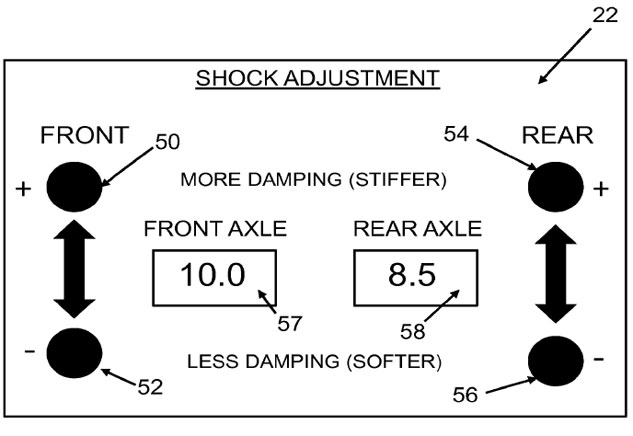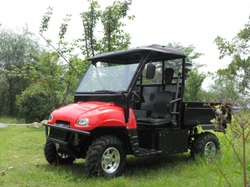Shocks feature real time on-the-go adjustments Here is how Polaris describes the continuously adjustable suspension system in the patent documents: A damping control system for a vehicle having a suspension located between a plurality of ground engaging members and a vehicle frame includes at least one adjustable shock absorber having an adjustable damping characteristic. The system also includes a controller coupled to each adjustable shock absorber to adjust the damping characteristic of each adjustable shock absorber, and a user interface coupled to the controller and accessible to a driver of the vehicle. The user interface includes at least one user input to permit manual adjustment of the damping characteristic of the at least one adjustable shock absorber during operation of the vehicle. Vehicle sensors may also be coupled to the controller to adjust the damping characteristic of the at least one adjustable shock absorber based on sensor output signals. In layman's terms, Polaris is looking to make fine-tuning your suspension easier. We're talking no tools, on-the-fly adjustability from the cockpit. You will be able to quickly and easily adjust the suspension for any time of terrain or any amount of payload. Electronic shocks will control the dynamic movement of each wheel (or ski or track, should this find its way to a snowmobile). The electronic shocks have a valve that controls the damping force of each shock. This valve may control compression damping only, rebound damping only, or a combination of compression and rebound damping. The valve is connected to a controller within reach of the driver in the cockpit. The patent documents are wide open when it comes to how this technology could be implemented. Polaris outlined three possible applications. 1 – The controller increases the damping of the shock absorbers based on user inputs received from the operator. 2 – The controller has several preset damping modes for selection by the operator. 3 – The controller may be coupled to sensors on the suspension and chassis to provide an actively controlled damping system. The most obvious place for this technology, at least in our opinion, is the RZR family of Sport Side-by-Sides. Those vehicles are at home everywhere from open desert to gnarly rock crawling areas to long-distance jump ramps. However, a less sexy but very useful home could be the Ranger line of Utility Side-by-Sides. Being able to adjust the suspension if you've got 1,000 pounds of cargo in the back and are towing 1,500 pounds through a rough worksite trail could be a lifesaver. Even Sport ATVs, like the now defunct Outlaw family, would be a great home this technology so you can go from trail rider to motocross racer in seconds. If any of this sounds familiar, it should. In car racing, the Lotus Formula 1 team started using active suspension back in 1983 and Mitsubishi introduced it to a production car in 1987. As well, both BMW and Ducati introduced their own versions of active suspension on motorcycles in recent years. Polaris differs in that its system lacks full suspension control, as the only the damping is adjustable for the cockpit – not the spring rate. The big question will be whether this ever makes it to market. We think it will (and fairly soon at that), but Polaris has to find a way to make it cost effective. For reference, when Ducati launched its active suspension (Ducati Skyhook Suspension) on the 2013 Multistrada 1200 S Touring, the price stayed the same. If Polaris can duplicate that, the response from consumers could be massive.
0 Comments
Leave a Reply. |
Categories
All
Archives
December 2019
|






 RSS Feed
RSS Feed
